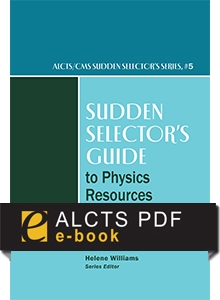Primary tabs
You don't need to be an ALA Member to purchase from the ALA Store, but you'll be asked to create an online account/profile during the checkout to proceed. This Web Account is for both Members and non-Members. Note that your ALA Member discount will be applied at the final step of the checkout process.
If you are Tax-Exempt, please verify that your account is currently set up as exempt before placing your order, as our new fulfillment center will need current documentation. Learn how to verify here.
- Description
- Table of Contents
- About the author
Selectors gain most of their knowledge on the job, which might provide some small comfort to those librarians who find themselves plunged into the world of business, perhaps even unexpectedly. The purpose of this book, part of the Sudden Selector’s Guide Series, is to help the sudden selector through the first few months of a new position. It is a guide to becoming a competent selector in a new area and all that it entails: joining associations, finding mentors, monitoring electronic discussion lists, and of course, learning how to select materials for your collection.
The language of physics can be baffling. Can you discern a quark from a gluon or a lepton? Does the thought of being a selector for materials in physics leave you dry-mouthed and shaky? Worry no more. In this guide, Michael Fosmire explains the basics of physics to the nonscientist, and lays the groundwork for collecting and using physics materials. He also provides an approachable introduction to:
- The different facets of physics as a discipline
- Liaison work with physics faculty and students
- Publication and information cycles in the field
- Lists of publishers, journals, and must-have core materials
- Cutting-edge information on open access initiatives in physics
Librarians with responsibilities for either physics collections or science reference will find a plethora of useful materials and resources in this guide, and will gain a valuable understanding of the field, what physics librarians do, and ways to use, build, and strengthen collections.
ForewordPrefaceIntroduction and Overview 1: What Is Physics?2: Physics Librarianship--Liaison Roles3: The Information Cycle of Physics4: Monographs5: Journals6: Preprints and Web Resources7: The Physics Community8: Emerging Issues in Physics Librarianship About the Author
Michael Fosmire
Michael Fosmire is Professor of Library Science and Head of the Physical Sciences, Engineering, and Technology Division of the Purdue University Libraries. Michael started at Purdue as the Physics, Earth, and Atmospheric Sciences (PEAS) Librarian more than a dozen years ago, coming to the profession after receiving a master's degree in physics and an MLIS from the University of Washington. He has a longtime interest in the professional development of sci-tech librarians, mainly through work in the Physics, Astronomy, and Mathematics Division of the Special Libraries Association, including founding the division's mentoring program and developing the physics section of a continuing education course, "Physical Science Reference for Non-Scientists." He edited the physics section of the Guide to Reference and currently edits the physics section of Resources for College Libraries. He has authored more than twenty peer-reviewed journal articles focusing on collections, information literacy, and information use in the science and technology disciplines. Two of his papers have been selected as Library Instruction Round Table (LIRT) Top 20 Library Instruction Articles (2005 and 2012) and he received the American Society of Engineering Education (ASEE) Engineering Libraries Division Best Paper Award and the ASEE PIC-IV Best Paper Award in 2012.



